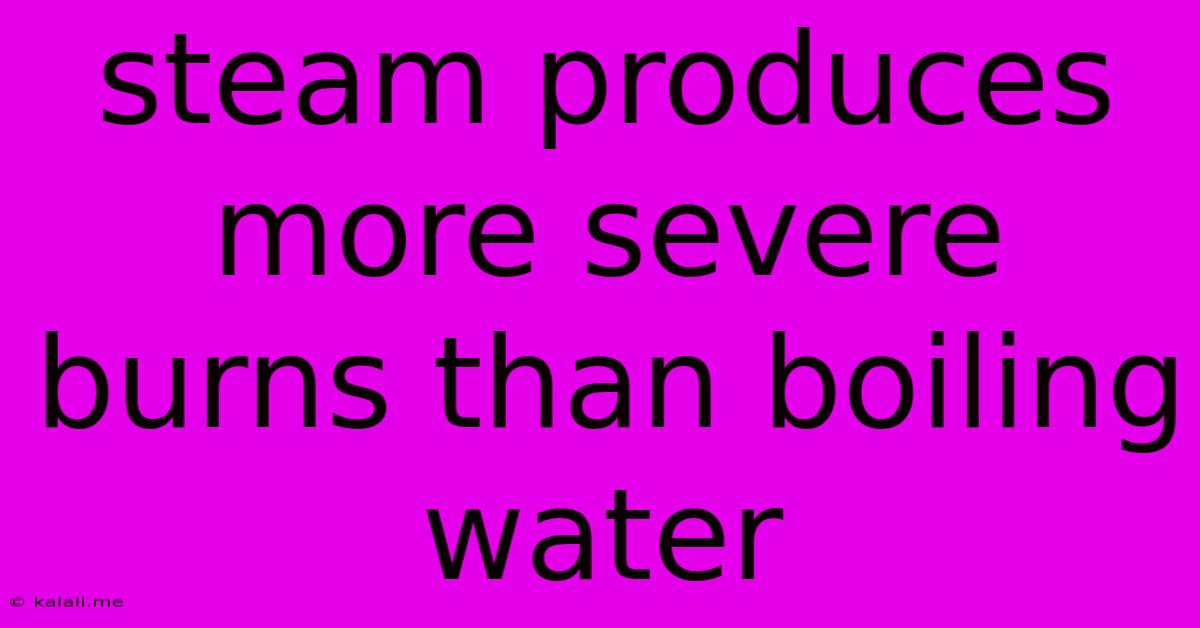Steam Produces More Severe Burns Than Boiling Water
Kalali
Jun 15, 2025 · 3 min read

Table of Contents
Steam Produces More Severe Burns Than Boiling Water: Understanding the Science
Meta Description: Discover why steam causes more severe burns than boiling water. This article explains the science behind steam burns, their severity, and how to treat them. Learn about latent heat and why steam's energy transfer is more efficient.
Boiling water and steam. Both are hot, both can cause burns, but one is significantly more dangerous. While seemingly counterintuitive, steam consistently produces more severe burns than boiling water of the same temperature. This isn't just anecdotal; it's rooted in the fundamental principles of physics. This article will delve into the science behind this phenomenon, explaining why steam burns are so much more damaging and what you can do to prevent and treat them.
The Science Behind the Scald: Latent Heat
The key difference lies in latent heat. Boiling water, at 100°C (212°F), possesses a certain amount of thermal energy. However, when water transitions from its liquid state to steam, it absorbs a significant amount of extra energy – this is latent heat of vaporization. This energy isn't reflected in a temperature increase; instead, it's stored within the steam's molecular structure.
When steam comes into contact with your skin, it doesn't just transfer the heat of its temperature; it also releases that stored latent heat as it condenses back into liquid water. This double whammy of energy transfer – the heat of the steam itself plus the latent heat of condensation – results in a much larger and more rapid energy deposition onto the skin. This rapid energy transfer leads to deeper and more severe tissue damage compared to a similar volume of boiling water.
Why Steam Burns are More Extensive
Beyond the increased energy transfer, the way steam interacts with the skin contributes to the severity of burns. Steam can penetrate clothing more easily than boiling water, extending the burn's reach and increasing the surface area affected. This is especially concerning for clothing made from materials that retain moisture. Further, the heat energy in steam transfers to the skin more effectively, leading to more extensive damage in a shorter timeframe.
Severity of Burns and Treatment
The severity of a burn, whether from steam or boiling water, depends on several factors including the temperature, duration of exposure, and the area affected. While first-degree burns cause redness and pain, second-degree burns involve blisters, and third-degree burns affect deeper tissues, potentially requiring extensive medical care. Steam burns, due to their inherent higher energy transfer, are more likely to result in deeper, more serious burns in the same timeframe of exposure.
First Aid for Burns:
- Cool the burn: Immediately run cool (not cold) water over the affected area for 10-20 minutes. Avoid ice or ice water.
- Remove restrictive clothing: Carefully remove any clothing or jewelry that's touching the burned area unless it's stuck to the skin.
- Cover the burn: Loosely cover the burn with a sterile, non-stick dressing.
- Seek medical attention: For serious burns (second or third-degree), seek professional medical care immediately.
Prevention is Key
Understanding the dangers of steam burns allows for better preventative measures. Always exercise caution when working with steam or hot water, using appropriate safety equipment like heat-resistant gloves and protective clothing. Maintaining awareness of potential hazards and ensuring proper ventilation in areas where steam is present are crucial steps in preventing serious steam burns.
In conclusion, while both boiling water and steam can cause significant harm, the latent heat released during steam condensation leads to more severe and extensive burns. Understanding this crucial difference allows for a heightened awareness of the risks and the implementation of appropriate safety precautions. Remember, prevention is the best medicine when it comes to avoiding steam burns.
Latest Posts
Latest Posts
-
What Is The Opposite Of Proud
Jun 16, 2025
-
Sum Of Odd Numbers 1 To 100
Jun 16, 2025
-
The Asthenosphere Is Part Of The
Jun 16, 2025
-
How Many Meters In A Square Mile
Jun 16, 2025
-
Organelles Which Contain Dna Include The
Jun 16, 2025
Related Post
Thank you for visiting our website which covers about Steam Produces More Severe Burns Than Boiling Water . We hope the information provided has been useful to you. Feel free to contact us if you have any questions or need further assistance. See you next time and don't miss to bookmark.